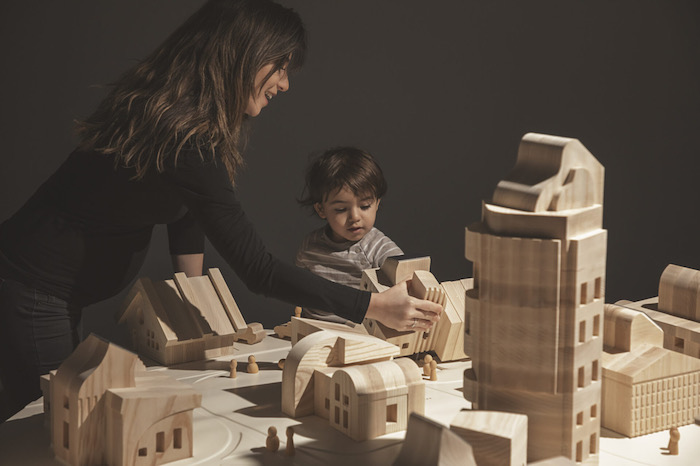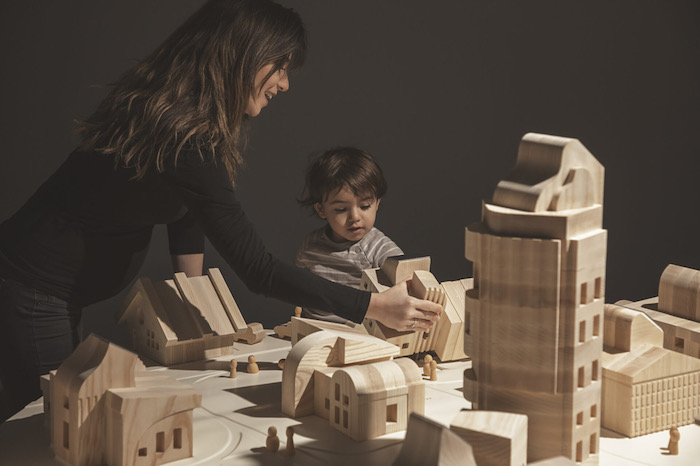SolarVille is a prototype neighbourhood that combines solar energy and blockchain technology to explore how communities of households could create their own renewable energy network and trade their excess energy directly at below market price.
Presently only a 1:50 scale wooden village using miniature panels and LEDs, it is a new project from the IKEA innovation laboratory, SPACE10, and on display in Copenhagen until the end of March. After that it will travel around the world.
Visitors can see the whole flow of energy through small LED lights embedded in the model that showcase electricity traded within the community in real time. Cables connect up the local neighbourhood, creating a stand-alone micro-grid.

Ikea’s SolarVille, photo: Irina Boersma
Peer-to-peer energy sharing
Peer-to-peer energy sharing networks running on blockchain already exist in places such as Brooklyn, Fremantle and Amsterdam’s Schoonschip, but if IKEA can make it as easy to adopt as the flatpack wardrobe, the idea could really take off.
In the UK IKEA has already partnered with one of the first solar companies ever founded, Solar Century, to sell PV panel installations through its stores and manages the Ingka franchise in stores in 30 countries, aimed at bringing affordable solar technology to homes there by 2025.
As a company, it’s also pledged to transform into the circular business and run on 100 per cent renewable energy.
SolarVille is a result of SPACE10’s research into how solar energy might change people’s lives, and sits in the context of Ikea’s larger sustainability goals and initiatives. It is particularly aimed at the off-grid 1.1 billion people around the world who still have little or no access to electricity, but could apply anywhere.

Ikea Space 10 Innovation Lab, photo: Alastair Philip Wiper
Blockchain reduces costs
As with other blockchain transactions, details of the exchanges between participants are logged in a secure and transparent ledger. Costs are reduced by bypassing intermediaries and enabling direct trade, and because by being automatic it inherently reduces transaction costs.
Torbjörn Lööf, chief executive officer of inter IKEA group, said that IKEA is “always looking for innovative ideas that can help more people live a better life within the limits of the planet. SPACE10 gives us new perspectives, discovering new opportunities within many different areas. It will be very interesting to learn how this combination of new technology and solar energy solutions can make lives better for the many people.”
Bas Van De Poel, SPACE10’s creative director, says: “Centralised energy systems are often too slow and economically inadequate to reach the billion people who remain locked in energy poverty.
“SolarVille showcases that, when working in tandem, technologies such as solar panels, microgrids, and blockchain open new opportunities: off-grid systems allowing people to leapfrog traditional grid electricity.”
SolarVille was designed with the help of blockchain experts BLOC, blocktech, and WeMoveIdeas, with architecture practice SachsNottveit designing the neighbourhood.
Space10’s previous products, designed to make a more planet-friendly meal, include a hydroponic farm, dishes made from algae and beetles, and an artificial meatball grown in a laboratory.
Co-living
SPACE10 has also recently published One Shared House 2030, the results of a collaborative survey into which goods and services – like kitchens, workspaces, smart devices, childcare and self-driving cars – people would be willing to share, and what kind of co-living space would suit them.
This showed that most respondents would like to live in tight-knit communities of different backgrounds and ages, of four to 10 people, with the exception of couples with children, who would prefer to be part of a slightly bigger community of 10–25 people – all providing that privacy issues were taken care of.
They would most like to share utilities, the internet, gardens, and workspaces – but, unsurprisingly, not bedrooms, and mostly not groceries or the bathroom.
Because they see shared living solutions as becoming more and more popular in the future, SPACE10 also asked a bunch of art students to imagine what such solutions could look like. Below is one of them:
Here comes the Uberisation of city life and the Airbnbification of domestic life
They refer to the “Uberisation of city life and the Airbnbification of domestic life”, applying the sharing economy to an entire neighbourhood.
Since IKEA – with Skanska – also manufactures a flatpack house and whole neighbourhoods, it’s not hard to imagine, by putting all of the above ideas together, how IKEA sees human beings living in the future – in small, connected communities, sharing energy and services, all supported by IKEA products.
Or we could all just go and sleep in the nearest IKEA store when it’s closed at night.
David Thorpe is the author of Passive Solar Architecture Pocket Reference, Energy Management in Buildings, and Sustainable Home Refurbishment
Tags: blockchain, coliving, ikea


